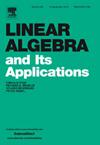Jordan type stratification of spaces of commuting nilpotent matrices
IF 1
3区 数学
Q1 MATHEMATICS
引用次数: 0
Abstract
An nilpotent matrix B is determined up to conjugacy by a partition of n, its Jordan type given by the sizes of its Jordan blocks. The Jordan type of a nilpotent matrix in the dense orbit of the nilpotent commutator of a given nilpotent matrix of Jordan type P is stable - has parts differing pairwise by at least two - and was determined by R. Basili. The second two authors, with B. Van Steirteghem and R. Zhao determined a rectangular table of partitions having a given stable partition Q as the Jordan type of its maximum nilpotent commutator. They proposed a box conjecture, that would generalize the answer to stable partitions Q having ℓ parts: it was proven recently by J. Irving, T. Košir and M. Mastnak.
Using this result and also some tropical calculations, the authors here determine equations defining the loci of each partition in , when Q is stable with two parts. The equations for each locus form a complete intersection. The authors propose a conjecture generalizing their result to arbitrary stable Q.
可交换幂零矩阵空间的Jordan型分层
一个n×n幂零矩阵B由一个划分PB (n)确定到共轭,它的约当类型由它的约当块的大小给出。在给定的幂零矩阵的幂零换子的稠密轨道上,幂零矩阵的Jordan型D(P)是稳定的——其部分至少成对相差两个——并由R. Basili确定。第二个作者与B. Van Steirteghem和R. Zhao确定了一个矩形表D−1(Q)的分区,其最大幂零对易子的约当型为给定的稳定分区Q。他们提出了一个盒子猜想,可以将有r个部分的稳定分区Q的答案一般化:它最近被J. Irving, T. Košir和M. Mastnak证明了。利用这一结果和一些热带计算,作者在此确定了当Q有两部分稳定时,D−1(Q)中每个分区的位置的方程。每个轨迹的方程构成一个完整的交点。作者提出了一个猜想,将其结果推广到任意稳定Q。
本文章由计算机程序翻译,如有差异,请以英文原文为准。
求助全文
约1分钟内获得全文
求助全文
来源期刊
CiteScore
2.20
自引率
9.10%
发文量
333
审稿时长
13.8 months
期刊介绍:
Linear Algebra and its Applications publishes articles that contribute new information or new insights to matrix theory and finite dimensional linear algebra in their algebraic, arithmetic, combinatorial, geometric, or numerical aspects. It also publishes articles that give significant applications of matrix theory or linear algebra to other branches of mathematics and to other sciences. Articles that provide new information or perspectives on the historical development of matrix theory and linear algebra are also welcome. Expository articles which can serve as an introduction to a subject for workers in related areas and which bring one to the frontiers of research are encouraged. Reviews of books are published occasionally as are conference reports that provide an historical record of major meetings on matrix theory and linear algebra.

 求助内容:
求助内容: 应助结果提醒方式:
应助结果提醒方式:


